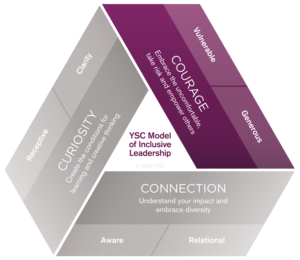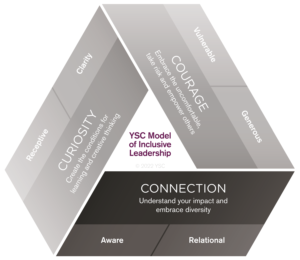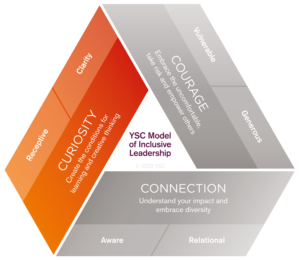Social and political shifts have disproportionate impact on different groups, but the COVID-19 crisis has amplified some of these patterns and added further complexity to how we interact and perceive others. With so much uncertainty clouding every decision and action, general suspicion and mistrust of others is on the rise. We should, therefore, stop to consider the threat – not of the virus itself – but the threat of fear, panic, and widespread distrust, which runs the risk of creating lasting implications for organizations and their people.
What we know is that the human brain is wired to react to threat with a flight or fight response. As the threat of the COVID-19 virus continues to prevail across the world and the impact widens – people and organizations are hard-wired to either run (flight) or respond with hostility (fight). Running sends signals of panic and closes down any opportunity for growth. Fighting, on the other hand, creates hostility and breeds behaviors such as blaming and shaming. These aspects of our psychology can be even harder to manage when our usual opportunities for connection and cues for compassion are restricted. As physical distancing and virtual working continues, the risk of unfounded beliefs and assumptions taking hold in our psyche increases dramatically. Without opportunity to sense check these beliefs, our unconscious biases have an uncanny knack for trumping our rational thinking. Swept up in the collective fear and panic, it would not be uncommon for many of us to “close our borders” to others. YSC’s Inclusive Leadership Model offers three pillars of inclusion that leaders, teams, and entire organizations can leverage to bolster inclusion in times of uncertainty. Whilst these behaviors are developable, having a level of self-awareness is a core starting point. Inclusive leadership is vital at this time to ensure all communities (marginalized and otherwise) are supported and seen despite social distancing. This is crucial for instilling a sense of security and belonging. As more and more people spend time away from their usual workplace due to illness, caring responsibilities or government guidelines, and with the impact of this disruption likely to impact us far into the future, we all need to find ways towards curiosity without suspicion, courage without drama, and connection without consequence…
The Challenge: Curiosity (without suspicion)
At times of crisis, leaders are likely to focus on action and rapid response. Many leaders are finding they have less time for considering alternatives or exploring what others think. The risk is that action orientation, without transparency and opportunities to contribute, isolates others and creates mistrust. People are likely to keep their thoughts to themselves, which results in missed opportunities for proactively sharing ideas and solutions to the problems facing businesses right now. Added to this is the challenge of virtual working, which requires intentional efforts to set up forums for collaboration. Teams can no longer just ‘huddle’ spontaneously. Instead, virtual collaboration requires more logistical coordination and its success is subject to the heightened level of attentiveness that a leader demonstrates when tuning in to all voices.
How to respond: As action and response is demanded, leaders should draw on broad sources and provide a clear rationale for any decisions taken. People can be united through clear processes for responding to the situation. Inviting ideas and alternative ways of resolving issues, signals openness and a willingness to learn from the challenges. While pace and action are critical at this time, inviting “bite size” contributions from broad groups makes a material difference to people’s sense of inclusion.
- Formal & Informal channels: Set up new ways of engaging your teams through virtual methods, both formal avenues like video conferences and informal avenues like blogs and videos. Regardless of the platform, remember to start with simple check-in’s, what are people’s peaks and troughs (personally and professionally)? This will help to gauge energy levels and surface potential challenges that may be standing in the way of others bringing their full selves to the fore. It may also be important to follow up group sessions with individual check-ins to provide extra support where necessary.
- Space to be heard: Within teams, agree ways to bring all voices into the virtual “room” – having mechanisms to ensure everyone is heard will minimize the risks of marginalization and isolation. Using chat and assigning smaller breakout groups into a private virtual room, can help elevate idea generation and creates more intentional opportunities for fluid thinking and discussion. Alternatively, you can remain attentive to the dynamics of the group and create space for quiet members to share their thoughts first, by proactively calling on them: ‘I would love to hear your reactions’.

The Challenge: Courage (without drama)
Leaders will not always immediately know the best course of action. Under pressure, we can easily be tripped up by our natural biases and our derailers. Some leaders may find themselves withdrawn, heads down to solve the crisis, and forget the need to reach out and connect. Others may become domineering and micro-manage the situation in an attempt to create certainty. In many instances, leaders have needed to revert to command-and-control styles to manage the initial impact of the crisis. However, if this becomes a more permanent operating style, leaders risk allowing power plays to override humility. Accumulatively, these behaviors risk closing others down and damaging the psychological safety that was established in steadier times. This is likely to disengage critical contributors to the recovery and redefining phase as organizations seek to establish a new normal.
How to respond: Demonstrating a willingness to challenge usual ways of operating, show vulnerability and taking some risks into the unknown, can inspire others to do the same. Leaders should call on people to leverage their strengths in new areas and amplify small but impactful contributions. Humility remains a critical balancing factor here to ensure genuine courage that is not driven by ego, but rather by a desire to influence for the greater good. Leaders who establish psychological safety will signal to others that it is safe to take interpersonal risks. Having the courage to demonstrate vulnerability will create an open, non-judgemental space for others, thereby diffusing misunderstanding and interpersonal drama.
- Reflect on biases and derailers. Creating time for reflection on your leadership impact is critical in a crisis, but often the first to go when pressures rise. Each leader should establish good habits for reflecting on how they react under stress, recognizing the triggers that may lead them to close down openness and interpersonal risk taking. This might involve reflective journaling, prioritizing coaching sessions and sharing personal learnings with others in a spirit of generosity and care. When personal self-reflection is proving difficult, identify an ‘accountability partner’ who can help to hold up the mirror to your biases and derailers and gently nudge you into awareness and action.
- Share experiences and reactions. Leaders should talk about their own reactions to the current pandemic, sharing their vulnerabilities and the challenges they are personally facing in terms of balancing caring responsibilities, supporting loved ones, and acknowledging the impact on their communities. This will help to deepen trust and humanize the diverse challenges individuals experience, helping to ease the pressure that others may be facing.
- Acknowledge difference. Recognize and acknowledge the impact this current state has on different populations and communities; consider who may be ‘the forgotten groups’ in all of this and identify a strategy for how to keep them connected and engaged. Reach out to diverse groups and/or leverage internal employee resource groups (ERGs) to determine what specific support may be needed.

The Challenge: Connection (without consequence)
In response to threat, individuals may respond by flight – receding further into isolation, or by fight – becoming increasingly hostile or aggressive as they grapple with their own fears. This can lead to relationship breakdowns and dysfunctional behaviors in teams. This can be exacerbated by the physical distance and the adjustments people have to grapple with as a result of virtual working. There is a risk that people are being asked to connect more in the virtual space, but meaningful connection is lost, as social cues are affected, and people lose their voice in the collective. Leaders have a role to play in ensuring that individuals remain connected to their colleagues and their purpose, despite physical restrictions on movement.
How to respond: Organizations will benefit from leaders who are able to acknowledge their own tendencies towards fight or flight in difficult times and are willing to make this part of open dialogue. This will help to normalize the difficult emotions people may be feeling and bring people closer together, regardless of geographical barriers. In turn this allows leaders to remain open to the diversity of experience and genuinely connecting with people where they are. Leaders will need to dial up their capacity to tune in, spotting those who may have receded and finding ways to connect with truth and meaning.
- Regular connection moments. Leaders should leverage technology to foster “little and often” touchpoints so that help people feel connected. Extending this beyond your immediate area by encouraging others to set up virtual coffees with a colleague abroad or setting up more formal buddy systems will support broader, business-wide connection and untap opportunities for collaboration.
- Don’t skip the small talk. Start every meeting with ‘how is everybody doing?’ and ensure there is time to share stories, concerns, personal challenges to build team resilience and connection. Making use of more informal communication channels to encourage colleagues to share pictures and stories of the innovative ways they are coping with the circumstance, can open up global connections and create cohesion through shared experiences.
- Channel your connections. Demonstrate the value that comes from different perspectives by spotlighting global colleagues during business updates and inviting regions to share their unique experiences. Respond to these stories with genuine empathy and invite broader conversations around shared challenges to build unity and cohesion.

